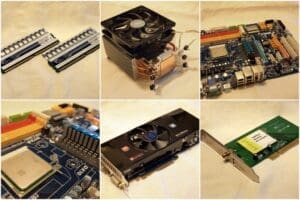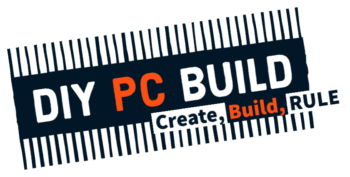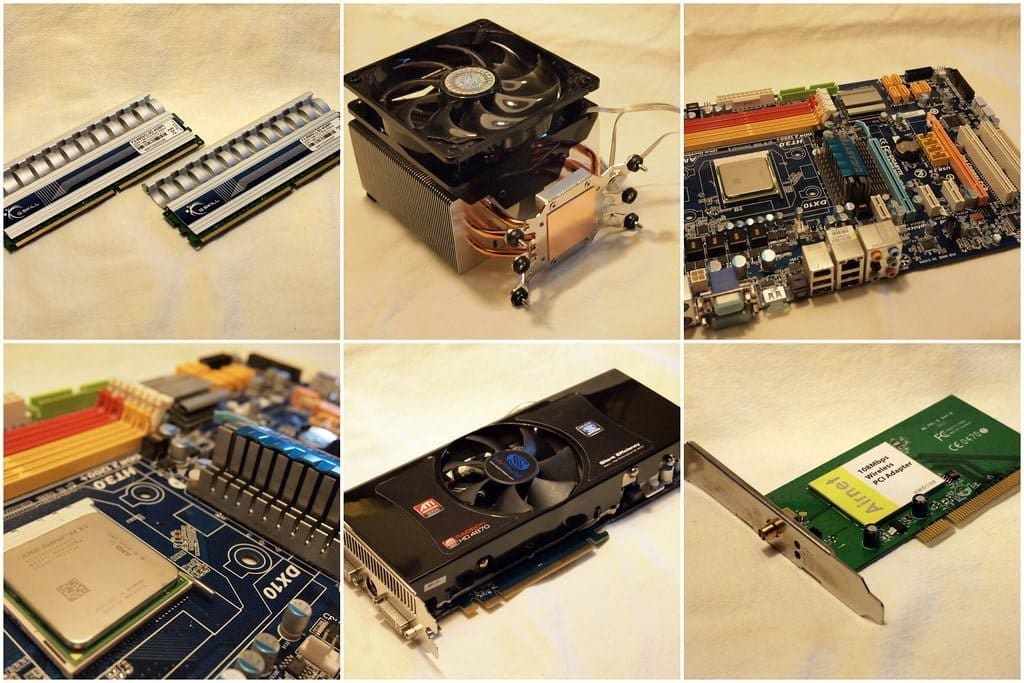
The best computer parts list we have here will be broken down into three parts. Every computer consists of a standard list of parts. Even your smartphone requires certain parts to be present to work as the mini-computer that it is.
The following will provide you with a parts list to build a PC, as well as additional items and accessories you might want to consider for your build.
Keep in mind these parts are not to view, hear or see what our computer is doing, but rather the necessary pieces to build a complete, but basic working computer.
Standard Parts to Build a Computer
- A computer Case
- A Power Supply or (PSU) for short
- Motherboard or (MOBO, MB)
- Processor or (CPU)
- Cooling; System and CPU
- System Memory or (RAM)
- System Storage or (M.2/SSD/HDD)
- System Graphics or (GPU)
The previous list are all the parts needed to have a working computer. Though your needs may vary, those are the basics to all PC’s. The last item on that list is slowly becoming less necessary, but to make life easy, I would suggest having at least a DVD drive to install Operating System(s) from DVD or other software you may have on disc. DVD is still a primary media for games, OS’s, and Software Programs that are not downloadable or come on USB.
Why wasn’t anything listed about network, sound, or display? These will be included with our Additional Parts List. They are not required to have a working computer, but they are extremely helpful to have. Additionally, many motherboards come with onboard networking, graphics (depending on CPU), and integrated sound.
Additional Parts to a Computer
As noted, the previous list includes what is necessary to have a working computer. What it doesn’t include can be considered as accessories, or they may already be included as a feature of another part.
For example, many motherboards (MOBO’s) have networking ports built-in, and ports for external display(s), sound, USB, and other features. If a MOBO has those ports, then it is fairly safe to assume that feature is already built-in to the part. Onboard graphics is usually available, but in recent years, it depends on a CPU that supports it.
To get a full list of what a motherboard may support, it’s best to seek out the specifics from our list of Manufacturer’s Websites and search for it there. The same would apply to many of the parts listed on our main components to build a computer.
Here are some additional parts you may want to consider in your build;
- Additional Storage
- Dedicated Networking Card
- USB Expansion Card
- Dedicated Sound Card
- Optical Drive (CD/DVD/Blu-Ray)
- Dedicated RAID Card
- Additional Cooling Fans, or Water Cooling Parts
- Dedicated or Additional Graphics Card(s)
- A Multi-Card Reader
Common Computer Accessories
Accessories enhance the usability of your computer build. There are lots of accessories out there, but we will list the common ones that most of us need (or want).
- Computer Monitor
- Computer Speakers
- Headphones
- Microphone
- WebCam (Camera for face to face communication over the internet)
- External Optical Drive (CD/DVD/Blu-ray)
- USB Drive
- USB Hub
- Mouse
- Keyboard
- Fan or Water-cooling Controller
- External Storage
Put Thought into your List
Now that you know the basic parts you MUST HAVE to build a working computer, you should also consider putting some thought into your parts list. Make sure you base your decision on parts that compliment your needs (or wants), and that you do your research to make sure the parts you choose will undoubtedly work together.
The best way to make sure your parts will work together is by going to the Manufacturer’s Website, and do a search for the product. The part we recommend doing this the most would be in your MOBO selection.
Many motherboard manufacturer’s will provide in-depth information about each MOBO, including details about compatible CPU’s, RAM, and graphics support. Do yourself a favor and at the very least, investigate the MOBO’s you are thinking about using. Compare them and decide which will give you the most of what you are looking for.
Once you have decided on a motherboard, deciding on other parts in your list becomes easier. You will know what size case you need, the brand of processor you can use (and hopefully supported models), what memory type you need (DDR3, DDR4, DDR5, etc. and supported speeds/timings). You will also know what kind of Graphics it supports, on-board, dedicated, or both – and what you can expand to if needed.

